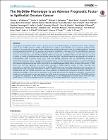| dc.contributor.author | MARTIN, CARA | en |
| dc.contributor.author | SHEILS, ORLA | en |
| dc.contributor.author | SMYTH, PAUL | en |
| dc.contributor.author | FINN, STEPHEN | en |
| dc.contributor.author | O'LEARY, JOHN | en |
| dc.contributor.author | GALLAGHER, MICHAEL | en |
| dc.contributor.author | BATES, MARK | en |
| dc.contributor.author | SPILLANE, CATHY | en |
| dc.date.accessioned | 2016-06-22T12:20:57Z | |
| dc.date.available | 2016-06-22T12:20:57Z | |
| dc.date.issued | 2014 | en |
| dc.date.submitted | 2014 | en |
| dc.identifier.citation | d'Adhemar CJ, Spillane CD, Gallagher MF, Bates M, Costello KM, Barry-O'Crowley J, Haley K, Kernan N, Murphy C, Smyth PC, O'Byrne K, Pennington S, Cooke AA, Ffrench B, Martin CM, O'Donnell D, Hennessy B, Stordal B, Finn S, McCann A, Gleeson N, D'Arcy T, Flood B, O'Neill LA, Sheils O, O'Toole S, O'Leary JJ, The MyD88+ phenotype is an adverse prognostic factor in epithelial ovarian cancer., PloS one, 9, 6, 2014, e100816 | en |
| dc.identifier.issn | 1932-6203 | en |
| dc.identifier.other | Y | en |
| dc.identifier.uri | http://hdl.handle.net/2262/76590 | |
| dc.description | PUBLISHED | en |
| dc.description.abstract | The prognosis of epithelial ovarian cancer is poor in part due to the high frequency of chemoresistance. Recent evidence points to the Toll-like receptor-4 (TLR4), and particularly its adaptor protein MyD88, as one potential mediator of this resistance. This study aims to provide further evidence that MyD88 positive cancer cells are clinically significant, stem-like and reproducibly detectable for the purposes of prognostic stratification. Expression of TLR4 and MyD88 was assessed immunohistochemically in 198 paraffin-embedded ovarian tissues and in an embryonal carcinoma model of cancer stemness. In parallel, expression of TLR4 and MyD88 mRNA and regulatory microRNAs (miR-21 and miR-146a) was assessed, as well as in a series of chemosensitive and resistant cancer cells lines. Functional analysis of the pathway was assessed in chemoresistant SKOV-3 ovarian cancer cells. TLR4 and MyD88 expression can be reproducibly assessed via immunohistochemistry using a semi-quantitative scoring system. TLR4 expression was present in all ovarian epithelium (normal and neoplastic), whereas MyD88 was restricted to neoplastic cells, independent of tumour grade and associated with reduced progression-free and overall survival, in an immunohistological specific subset of serous carcinomas, p<0.05. MiR-21 and miR-146a expression was significantly increased in MyD88 negative cancers (p<0.05), indicating their participation in regulation. Significant alterations in MyD88 mRNA expression were observed between chemosensitive and chemoresistant cells and tissue. Knockdown of TLR4 in SKOV-3 ovarian cells recovered chemosensitivity. Knockdown of MyD88 alone did not. MyD88 expression was down-regulated in differentiated embryonal carcinoma (NTera2) cells, supporting the MyD88+ cancer stem cell hypothesis. Our findings demonstrate that expression of MyD88 is associated with significantly reduced patient survival and altered microRNA levels and suggest an intact/functioning TLR4/MyD88 pathway is required for acquisition of the chemoresistant phenotype. Ex vivo manipulation of ovarian cancer stem cell (CSC) differentiation can decrease MyD88 expression, providing a potentially valuable CSC model for ovarian cancer. | en |
| dc.format.extent | e100816 | en |
| dc.language.iso | en | en |
| dc.relation.ispartofseries | PloS one | en |
| dc.relation.ispartofseries | 9 | en |
| dc.relation.ispartofseries | 6 | en |
| dc.rights | Y | en |
| dc.subject | Cancer | en |
| dc.title | The MyD88+ phenotype is an adverse prognostic factor in epithelial ovarian cancer. | en |
| dc.type | Journal Article | en |
| dc.type.supercollection | scholarly_publications | en |
| dc.type.supercollection | refereed_publications | en |
| dc.identifier.peoplefinderurl | http://people.tcd.ie/osheils | en |
| dc.identifier.peoplefinderurl | http://people.tcd.ie/cmartin3 | en |
| dc.identifier.peoplefinderurl | http://people.tcd.ie/cspilla | en |
| dc.identifier.peoplefinderurl | http://people.tcd.ie/smythpa | en |
| dc.identifier.peoplefinderurl | http://people.tcd.ie/finns | en |
| dc.identifier.peoplefinderurl | http://people.tcd.ie/batesm1 | en |
| dc.identifier.peoplefinderurl | http://people.tcd.ie/olearyjj | en |
| dc.identifier.peoplefinderurl | http://people.tcd.ie/gallagmi | en |
| dc.identifier.rssinternalid | 100328 | en |
| dc.identifier.doi | http://dx.doi.org/10.1371/journal.pone.0100816 | en |
| dc.rights.ecaccessrights | openAccess | |
| dc.subject.TCDTheme | Cancer | en |
| dc.subject.TCDTag | Predictive Biomarkers | en |
| dc.subject.TCDTag | computer-assisted language learning | en |
| dc.identifier.orcid_id | 0000-0002-4493-9496 | en |
| dc.subject.darat_thematic | Health | en |
| dc.status.accessible | N | en |




